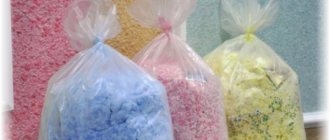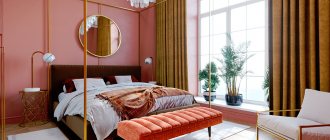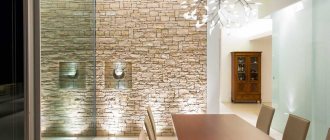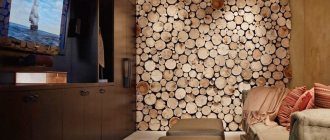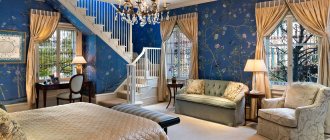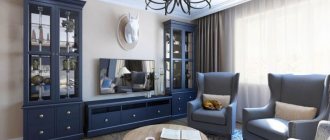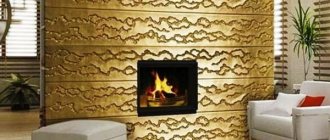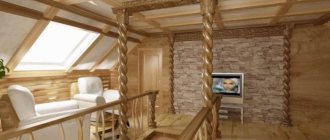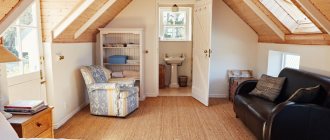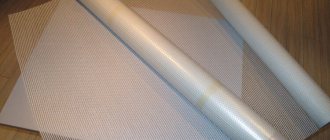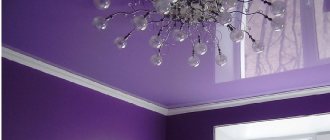What is liquid wallpaper?
There is no clear opinion about the difference between decorative plaster and liquid wallpaper. Some believe that liquid wallpaper is a type of finishing plaster, others, on the contrary, that liquid wallpaper is a mixture that combines the properties of plaster and wallpaper. One thing is clear: these concepts should not be identified - they meet different requirements, have different textures and are applied to the surface differently.
Liquid wallpaper contains cellulose fiber and glue. Depending on the decor, you can add cotton and silk fibers, dyes and all kinds of relief elements to the composition: wood chips, algae and mica, sand and much more.
By the way, their composition determines the first and main advantage of liquid wallpaper - a huge variety of colors, patterns, textures, thanks to which they can be used as decoration for almost any room in the house, office or public places.
Advantages and disadvantages
Of course, there are many advantages of liquid wallpaper over regular wallpaper, but it cannot be said that they are an ideal wall covering.
Advantages of liquid wallpaper:
- Safety – do not contain harmful components.
- Seamless – the absence of unaesthetic seams and the need to join the pattern.
- Long service life.
- Resistance to temperature changes.
- They have sound insulation quality.
- Maintainability - water will help you easily remove and replace the damaged area with a new mixture.
- Good coverage of walls with minor defects.
- Easily glued in hard-to-reach places.
- Easy removal.
- They don't collect dust.
High-quality installation Source top-1000.ru
Disadvantages:
- Low moisture resistance - cannot be used in rooms with high humidity.
- Dry clean only.
- High price.
- Long-term installation - dry for several days.
- Low mechanical strength - easily deteriorates under mechanical stress. This means that children can easily render them unusable through careless handling, and animals can scratch or chew them. But it won’t be difficult to replace a damaged area even just spot-on.
- The color range of liquid wallpaper for walls is more modest compared to roll wallpaper.
To increase the service life, it is necessary to follow the installation technology Source oooalfa-pro.ru
Compound
As mentioned above, high-quality liquid wallpaper does not contain critical ingredients that can be harmful to health. An exception may be low-quality products from unscrupulous manufacturers.
- Liquid wallpaper is based on cellulose or cotton fiber, which makes up about 90% of the total composition. Often, waste paper, wood and textiles are used after recycling.
- Additives to improve technical characteristics. Antiseptics are added to increase resistance to mold, mildew and bacteria on the surface.
- Membership Basis. You can use an envelope, PVA, wallpaper glue, or paste as glue.
- Various types of decorative additives. Additives solely for aesthetic effect and texture: beads, sequins, silk fibers, dyeing, flock, velor.
Color palette
Liquid wallpaper is an excellent finishing material for any type of surface, be it a ceiling or a wall. They gained their popularity and demand thanks to a huge palette of colors and textures. A wide range of colors allows you to choose from the lightest to the darkest tones in any area of the spectrum.
The magic wand in the design of the establishment is the “flower wheel” shown in the photo below. Thanks to him, even a beginner can cope with the color scheme. Designers are encouraged to choose background colors that are on the opposite side of the spectrum to create contrast; neighboring tones are used to highlight similar tones.
To decorate a separate room, its individual colors are selected. So, for office premises, strict shades of gray or beige will help create a corporate atmosphere. To make the coating more refined with a touch of charm, special additives are added to the dough. For example, gold threads can add luxury.
To achieve different color effects, manufacturers begin to create specific compositions. They can contain natural fibers of cotton, silk, cellulose, as well as various dyes, all kinds of crumbs, and so on.
Manufacturing companies can sell such mixtures either in one package, where all the components are already mixed, or in a kit, which includes several packages, where each component is separately.
Mixing should be done in accordance with the instructions on the material packaging. Then there are tips on creating a specific shade and what will pair perfectly with what.
Through the efforts of manufacturers and designers, collections of such wallpapers have been created, which differ not only in composition, but also in color saturation. Most of them are available in soft, soothing colors that help create a cozy and comfortable atmosphere in the room.
Despite the huge variety of colors, solid matte tones are even closer to liquid wallpaper. They mainly play a supporting role in interior decoration. But if you want, you can always create a bold interior by adding a little brighter paint.
A wide palette of colors and various textures allow you to create original visual effects, convey the volume of the image and the depth of the idea. And the different direction of application also allows you to add a play of light and shadow to such a wall.
Living room
Liquid wallpaper is great for decorating a living room. Thanks to the soft and pleasant-to-touch surface, liquid wallpaper in the living room interior creates an atmosphere of comfort. Silk or combined ones look especially good - they create the impression of soft textiles on the walls.
An example of using silk wallpaper in the living room Source domdom.com.ua
It is not necessary to cover the entire surface. Sometimes it is enough to select only one wall.
For the living room, the best option to emphasize the unusualness of the interior is to decorate the wall opposite the sofa Source design-homes.ru
An even more economical option is to allocate one zone.
Beautiful combination Source andromeda1.rf
For those who want a more original design, decorative inserts have been invented. As a rule, they can be ordered individually. In addition, the drawing will add unusualness to the room.
Additional decor Source sense-life.com Interesting design Source basketgoods.ru Cozy living room Source prom.st
Types of liquid wallpaper
Liquid wallpaper is a safe and environmentally friendly product. Externally, this finishing material resembles decorative plaster, the difference is that it does not contain sand and concrete.
Depending on the main component, the following types of wallpaper are distinguished, which differ from each other in appearance, feel and price:
- Pulp is the cheapest option due to the low cost of the starting material. Their surface is slightly embossed, reminiscent of matte paper.
- Cotton fibers give the surface porosity and softness.
- Silk threads up to 6 mm long in the wallpaper give it shine. The price depends on whether it is natural silk or artificial silk. Natural lasts a long time and does not fade in the sun.
- In combination, cellulose is used as the main raw material with the addition of cotton and silk threads.
They are suitable for decorating children's rooms and other living spaces, as they contain natural ingredients.
Natural coating materials make it breathable, and a thickness of up to 4 mm gives them heat and sound insulation properties.
The coating does not emit harmful substances even when exposed to high temperatures.
Briefly about the main thing
Liquid wallpaper is an excellent solution for living rooms that you want to add originality and comfort. They are easy to glue and repair, and you can use them to create any design. But you shouldn’t glue them in rooms with high humidity, although it all depends on how liquid wallpaper is used in living rooms.
They will fit perfectly into living spaces, making them softer and more atmospheric. They can be used both on the entire surface and on a separate wall. Can be combined with other coatings. The highlight can be a pattern or sparkles.
Wallpaper is good for a child's room, where you can use it to draw anything. You can add textiles, beads, sparkles and fluorescent to the composition.
It is not advisable to use them in the kitchen, but if desired, the wallpaper can be varnished, this will increase its moisture resistance.
Ratings 0
Advantages
Fine powder with dye and adhesive binder, which is diluted with water according to the instructions before work, is usually called wallpaper precisely because of the cellulose.
What is better, liquid wallpaper or regular wallpaper? Experts highlight the positive and negative aspects of this type of decorative coating.
Benefits include:
- Apply quickly and easily. According to positive reviews of liquid wallpaper, the repair process does not exceed 10 hours;
- Don't accumulate dust. The product contains special additives that have a dust-proof and moisture-proof coating;
- They have good thermal insulation. Such wallpaper reduces the appearance of drafts;
- Ecological composition. As noted above, no chemical or toxic substances are used to produce this model of finishing material;
- During the application process, no joints are formed and no matching of decorations is required;
- They have good soundproofing qualities. Cellulose, in contact with PVC compounds, forms a dense shell on the wall surface that perfectly absorbs loud sounds;
- Cracks do not appear even after prolonged use;
- Some types absorb moisture well. For example, when choosing liquid wallpaper for the kitchen, you need to take into account the presence of additional water-repellent impregnation. Its presence is indicated in the product composition. In the cooking area there is always high humidity and sudden temperature changes, which negatively affects the condition of decorative coatings;
- They can be used to create three-dimensional images on the surface of the ceiling and walls. For example, when creating designs with liquid wallpaper, you will need a denser composition. To do this, in the process of preparing the working composition, the proportion of water is reduced by one and a half times. In this way, a paste-like substance is obtained, with the help of which it is easy to create a three-dimensional texture or a unique pattern;
- Easy to prove. To do this, you can use a regular construction spatula. If deformations of animal nails appear on the wall, a small amount of the composition can correct the situation and return the interior to its original appearance.
The material, in fact, differs from traditional wallpaper and is more related to decorative plaster.
Material characteristics
Like any building material, liquid coatings have instructions for use, composition and installation recommendations.
Decorative coatings consist of natural fibers, dye and KMS glue. All components are absolutely harmless, so finishing can be done in children's rooms and rooms where people prone to allergies live.
In addition to the main composition, almost every type of wallpaper comes with decor in a separate package. These can be colored granules, stone chips, sparkles, bright threads.
Liquid wallpaper is gaining increasing recognition due to its excellent characteristics:
- vapor permeability;
- environmental friendliness;
- elasticity;
- excellent adhesion to the base material;
- long-term operation;
- Possibility of use in any premises (residential, domestic, office, administrative);
- easy installation.
Flaws
Despite all the advantages, liquid wallpaper is still not as common as traditional wallpaper for the following reasons:
- High price. Traditional ones have a wider range of prices, which is required for any wallet. Liquid ones are more expensive, on average about 1000 rubles. And more per kg of dry matter. Approximate consumption: 1 kg per 4-5 m2. The smaller the particles in the mixture, the higher the cost.
- More limited color selection. The range is expanding, but still inferior to the usual ones.
- It cannot be washed. You can paint the surface with acrylic paint, but this will deprive it of breathability.
- If there was a stain of a contrasting color under the decorative layer, over time it will appear on the outside.
- It takes an average of 2-3 days to dry, depending on the season.
Liquid wallpaper is purchased dry, after which it is diluted with water before use. The mixture is suitable for application to walls, ceilings, structures of any shape.
Advantages and disadvantages
If we talk about the general impression, some people like liquid wallpaper, others don’t. But their properties are not bad. The advantages include the following qualities:
- Seamless surface. No joints like wallpaper. Smooth surface.
- If necessary, the imperfections of the walls are smoothed out, but this increases the consumption of the composition.
- The composition is vapor permeable, that is, it does not create problems for maintaining normal humidity in the room.
- Fits well on curved surfaces of any complexity.
- Easy restoration for any type of damage. There are two possibilities: for minor damage (scratches), simply wet it, wait a couple of minutes and smooth it with a spatula; This defect is easy to fix
- If there is a change in color or a significant defect, remove the old coating and apply a patch.
Not bad qualities. What is most impressive is the high maintainability. This is good if you have pets: scratches are simply rubbed out. If you also like the appearance of this coating, you should try it.
Liquid wallpaper also has disadvantages:
- They fade under the sun. In the southern room this must be kept in mind.
- Cleaning is dry only: you can collect dust using a vacuum cleaner and a soft brush.
- It is impossible to remove ingrained dirt and grease. Just remove the contaminated piece and apply a patch.
- Doesn't fit well on all surfaces. The easiest way to work is with rough ones, the worst thing is with absolutely smooth ones (the composition “drains”). High maintainability - this is one of the best properties of wet wallpaper
- For a good result, surface preparation is necessary - leveling significant unevenness, priming in several layers. If the surface has an uneven color, painting is also needed (usually white).
- Self-application requires a lot of time.
As you can see, there are some pretty serious drawbacks. The most unpleasant thing is the impossibility of wet cleaning. This is not always acceptable in the hallway or kitchen. This drawback can be mitigated by covering the wall with varnish. It can be washed, but cannot be restored. In addition, the varnished coating loses vapor permeability, but becomes water-repellent.
What rooms are they used for?
This material can be used in almost any area of the apartment, from the nursery to the bathroom, kitchen and hallway. See design examples for different rooms.
Living room and bedroom
Liquid wallpaper is ideal for decorating a bedroom and living room, both from an aesthetic point of view and in terms of tactile sensations. A pleasant to the touch and interestingly textured coating is the finishing with silk plaster - liquid wallpaper, which contains silk and cotton fibers. With them, the room will look very cozy, as if covered with textiles.
To add originality to the mixture, you can add a little glitter or even fluorescent paint, causing a slight flicker in the light and glow in the dark.
You can also highlight one of the walls in an original way (in the living room, this is the wall that the eye will rest on from the sofa; in the bedroom, this is the headboard area) using textured plaster or liquid wallpaper from a large motley area.
Golden Venetian plaster (“marble dust”) looks rich and elegant in a classic way. It creates a unique deep light on the walls, a cozy glow, play of light and shadow along with barely noticeable cracks and veins. This design of a living room or bedroom will not leave anyone indifferent.
Adding granules and flock will create three-dimensional images and enliven the plain surface of the walls. This design technique is also used to visually expand the room.
Children's room
How else can you decorate a children's room in an original way, if not with the help of liquid wallpaper. A room like this:
- Safer: the walls here breathe, do not create a greenhouse effect and do not accumulate dust;
- it's more interesting: unlike the paper alternative, here you create any design you like and can even invite your child to work. A room decorated with liquid wallpaper will look much cozier than a painted room. Season it with decorative elements, glitter, fluorescent paint.
- Always ready for children's experiments and “surprises”. If you don’t always clean “children’s creativity” from ordinary wallpaper, then in the case of liquid wallpaper you can always cover the wall painted by the child.
Kitchen
Those who are determined to decorate the kitchen with cellulose pulp should consider how to cover the work area: either by treating the wallpaper with a layer of paint, or instead of ceramic tiles. The fact is that the decorative coating does not tolerate contact with water, so it is not recommended to use it in the work area without applying a layer of protective varnish.
Please note that paint changes the texture and properties of the coating. In general, liquid wallpaper is appropriate in the kitchen, as it does not absorb odors and is easy to clean.
Stains on them can be erased with an eraser or the damaged area can be restored.
It’s easy to zone a kitchen space using cellulose-adhesive mass - it doesn’t require straight lines and allows you to make a contrasting transition or a smooth gradient while maintaining texture.
You can use an envelope, PVA, wallpaper glue, or paste as glue.
Several design options:
- In a studio kitchen, you can visually separate the entire area, including the ceiling cladding, with a set.
- Highlight a large area or niche with color.
- On the wall in front of the set, apply a large design - coffee cups, fruits, cake.
Additives solely for aesthetic effect and texture: beads, sequins, silk fibers, dyeing, flock, velor.
Corridor
It may seem that such a covering is not the best option for a hallway or hallway. But that's not true. When clear varnish is applied to the top, the walls achieve the required coating strength.
For the hallway and corridor, you need to select a design that blends organically with the design of the rest of the rooms.
An excellent solution for gluing such wallpaper in the hallway
Liquid wallpaper creates all the conditions for combination and goes well with various finishing materials:
- masonry;
- wild stone;
- gypsum plaster;
- textured plaster, etc.
Easy to match with many types of finishes
Monochrome wall design is the embodiment of elegance and a sense of proportion. But in some rooms this approach may seem boring and uninteresting.
You can add more intricate lines or patterns to liven up your interior. To realize your imagination, you can easily combine liquid wallpaper of different colors with each other, combine it with other finishing materials, or use it only to create patterns.
Create intricate designs for a more dramatic look.
These can be individual lines or entire fragments with patterns that can be organized:
- vertical;
- horizontally; inclined;
- waves;
- abstract patterns;
- spirals and so on
More complex pattern reproduction with combination
Do you have a small corridor? So pay attention to light shades of liquid wallpaper. Dark ones may seem more practical, but they tend to affect the feel of the room. It will look smaller, darker and awkward, which is completely undesirable.
Universal shades in design are:
- beige;
- gold;
- gray tones;
- fishing.
If possible, it is advisable to equip the hallway and hallway, which in most cases lack natural light, with additional light sources.
Bathrooms
Manufacturers guarantee that liquid wallpaper is not afraid of moisture and can be used in bathrooms and toilets. In this case, you need to take into account the characteristics of the material you use.
- The technology involves covering the walls with a strong water-repellent impregnating solution. For what? So that moisture, penetrating 10-15 cm into the wall, does not attract fungus, mold and rust from the fittings on the surface. The cotton, cellulose and silk included in the mixture actively absorb all this and are painted in the appropriate colors.
- This wallpaper is reusable. To remove them from the wall, simply spray them with water, let them soak, and scrape them off with a putty knife. Upon contact with water, the material becomes soft and plastic. It can be easily removed from the wall, moved to another place, laid down and left to dry. This is how transference and recovery occur.
If you decorate a surface in a damp area with this mixture, the material will become saturated every time you take a bath. It can be accidentally torn from the wall. Returning it is just as easy. But why such difficulties?
The conclusion suggests itself. If you want to cover the walls in the bathroom with this composition, protect it from water with paint. Or use away from damp places.
Decorating the ceiling with liquid wallpaper
Liquid wallpaper is successfully used to decorate the ceiling in any room. Ease of use allows finishing work to be completed in a short time. Below are photos of this unique material.
If you want to achieve an environmentally friendly, durable and aesthetic finish in your apartment and spend a minimum of time and effort, liquid wallpaper will be an excellent choice.
Application Tools
You can stick liquid wallpaper and distribute it evenly over the surface using several well-known means. Next we will discuss what these devices are.
Putty knife
The spatula is excellent for applying such materials. It is recommended to use for the reason that it allows them to be evenly distributed over the surface. With its help there are no “cracks”, irregularities and uneven structure.
Trowel
A trowel, like a spatula, allows you to achieve perfect gluing of wallpaper to the walls. Both tools are almost identical and the choice depends only on your desire.
Brush
They can not only be painted to increase moisture resistance, but also glued to this base. The paint gives them good strength and durability.
Stencils
Stencils are used when applying liquid wallpaper if you need to create a beautiful pattern on the walls. Stencils come in completely different sizes and form factors. They help create unique designs designed to freshen up a room and give it a unique personality.
How to apply liquid wallpaper
Liquid wallpaper is applied to the surface of the walls in a thin layer, as a result of which the base is leveled, minor defects are eliminated and the presence of seams is eliminated. Thanks to this, an ideal basis for finishing is obtained, which is why many apartment owners wonder whether it is possible to glue wallpaper onto liquid wallpaper.
Using a stencil and liquid wallpaper, you can create interesting drawings and inscriptions on a prepared and painted wall
This procedure is possible, but under certain conditions:
- no damage to the liquid wallpaper layer;
- absence of bubbles under the surface of the finishing material;
- absence of delamination, dirt and other defects.
If the finishing surface does not meet the listed requirements, it is necessary to carry out partial repairs of liquid wallpaper in problem areas or completely remove the coating.
How to remove liquid wallpaper from a wall:
- dip it from a spray bottle and remove it with a spatula;
- using an industrial hair dryer;
- using a straight grinder;
- using a grinder;
- applying a special solvent for wallpaper.
It is necessary to mix the mixture strictly following the instructions on the package
If you can’t completely get rid of liquid wallpaper, you can disguise it. In this case, highly protruding areas are carefully smoothed over the embossed coating and roughness is created on the smooth surface to improve adhesion.
Application Features
To understand whether you can stick them on yourself, it is better to familiarize yourself with the technique of decorating walls with liquid wallpaper. The technique involves several steps:
- Surface preparation: cleaning the walls from the previous layer of wallpaper, grease stains, whitewash. Removing crumbling and uneven coating. Elimination of major defects.
- Applying the finishing coat.
- Applying wallpaper directly: according to the manufacturer's instructions, dilute with water and mix in the necessary decorative elements, leave the mixture for the time indicated on the package. Then it can be applied in several ways:
Application using a spatula Source kraski-net.ru
Using a roller Source sanmarco-vernici.ru
See also: Catalog of companies that specialize in finishing materials and related work
You can apply a thin layer of coating using a special compressor Source umcos.ru
What surface can it be applied to?
I understand how liquid wallpaper can be applied. It's time to think about what surfaces can be made and recommended.
On drywall
Drywall is a good material for these options. Thanks to the smooth and even surface there are no problems with application. In addition, the latter perfectly masks seams and seams of drywall, which will definitely work to your advantage.
For paint
There are no prohibitions limiting the application of liquid wallpaper to painting. The only thing you should be sure of before starting work is that the paint on the wall is applied with high quality, does not peel off anywhere and has no cracks.
Helpful tip: If you want these options to fit better on the painted surface, brush it with a wire brush so they will “stick” well.
On OSB boards
Liquid wallpaper can be glued to E0 class OSB boards. The only thing you need to do before gluing is to close the seams between the plates and treat the surface with a special primer.
These manipulations improve adhesion and ensure that, after gluing, the substances that make up these plates do not escape through them.
Making drawings with liquid wallpaper
- Draw a sketch of the design on the surface with a pencil.
- Apply the mixture with a spatula along the contour of the design.
- Dried dates (3-4 hours). Apply a different color. Distribute the mixture evenly.
An excellent solution for decorating the interior of a bedroom, children's room, or hallway would be to use wallpaper made from liquid materials.
The only areas where such wallpaper should not be used are the kitchen and bathroom. There is a high probability of rapid contamination in the kitchen, and high humidity in the bathroom.
Use in interior design
The use of liquid wallpaper in the interior allows you to implement various design ideas. Combine them, creating both simple compositions and huge panels.
You can combine the colors of liquid wallpaper in various ways:
- the use of different shades of wallpaper makes it possible to visually increase the space, change the distance to the ceiling, and influence the lighting of the room;
- By combining several colors and shades of wallpaper, you can create various compositions, geometric and mosaic designs. This approach will look harmonious both in the living room and in the children's room;
- it is possible to create decorative volumetric elements;
- using two or more colors, you can create floral patterns, abstract figures, images of animals;
- Liquid wallpaper, thanks to its rich color palette, will allow you to create panels with fairy-tale characters, simple figures, etc. in a children's room. Look how beautiful it looks in the photo;
- Wallpaper in a marine color scheme will look harmonious in the bathroom. For example, seascape, starfish, etc.;
- A good design solution would be a combination of black and white liquid wallpaper.
Before you start decorating the walls with wallpaper, you can sketch out the design in pencil. This will ensure ease of working with this material.
How to make liquid wallpaper at home with your own hands
Here is a trick for creating liquid wallpaper at home, and this method proves that the disadvantage of “high price” is very relative. With a little ingenuity and creativity, you'll end up with something like this:
- We take paper (regular A4 will do, you can even get your drafts dirty). We cut randomly, the smaller the better. On average, the pieces are 3-4 cm.
- We pour water into the container in which our mixture will be located in the future, for example, according to the principle “this bucket is not a sin.” The water should completely cover the paper, but not too much so that the solution becomes too liquid. Leave for 2-3 hours until the paper is completely wet.
- Using a construction mixer, grind the soaked sheets into as homogeneous a mixture as possible.
- Add dye, chalk, vinyl glue (proportions for 1 sheet of paper - 1 teaspoon of chalk and 5 ml of glue), mix again. You can add decorative elements: chips, glitter, etc.
- Apply with an iron spatula to a dry prepared surface with a layer of 3-4 mm, let dry.
This simple master class will allow you to decorate your walls in an original way almost free of charge.
How to find out the consumption of liquid wallpaper per 1 square meter
Based on the consumption of liquid wallpaper per 1 square meter, you can determine how cheap the material is and how much the finishing work will cost. By comparing the result obtained with the price of the dry mixture in the store, you can determine the feasibility of such a purchase. In most cases, the manufacturer indicates in the instructions how much material is needed to process 1 m².
Typically, one package (1 kg of mixture) is enough to treat 5 m² of surface. However, these figures are approximate.
When calculating the consumption of liquid wallpaper, the following factors should be taken into account:
- To prepare the solution, 6 liters of water are added to the dry mixture, which affects the volume of the material.
- The coating is applied in a thin layer, so a small amount of solution is required to treat the surface.
Liquid wallpaper on the entire wall should be applied from one batch, which ensures uniform texture and color of the coating
Considering the characteristics of the material and customer reviews on forums, liquid wallpaper has more advantages than disadvantages. This statement is true provided that all technology requirements are strictly observed.
If you do not have the skills to work with liquid wallpaper, excessive consumption or waste of material is possible. It is better to entrust the work to professionals, since incorrect actions can bring more disadvantages than advantages.
How to care for liquid wallpaper
Maintenance of the coating is necessary, but it is not at all difficult, sometimes the entire surface has to be vacuumed and vacuumed. If using a brush attachment, use a very soft one.
If a section of the lining is damaged, replacing it is very simple. First, the damaged area is sprayed with a spray bottle, and then a layer of material is removed with a spatula. Next, a new layer is applied and leveled.
